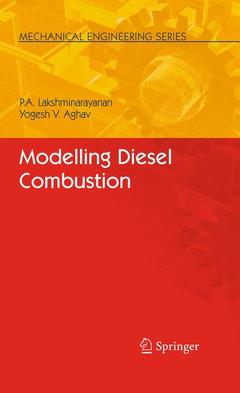Description
Modelling Diesel Combustion, 2010
Mechanical Engineering Series
Authors: Lakshminarayanan P. A., Aghav Yoghesh V.
Language: English
Subjects for Modelling Diesel Combustion:
Keywords
Combustion; Emission; design; internal combustion engine; model; modeling; simulation; turbulence
158.24 €
In Print (Delivery period: 15 days).
Add to cart
Modelling Diesel Combustion
Publication date: 05-2012
305 p. · 15.5x23.5 cm · Paperback
Publication date: 05-2012
305 p. · 15.5x23.5 cm · Paperback
158.24 €
In Print (Delivery period: 15 days).
Add to cart
Modelling diesel combustion (Mechanical engineering series)
Publication date: 03-2010
305 p. · 15.5x23.5 cm · Hardback
Publication date: 03-2010
305 p. · 15.5x23.5 cm · Hardback
Description
/li>Contents
/li>Comment
/li>
Phenomenology of Diesel Combustion and Modeling Diesel is the most efficient combustion engine today and it plays an important role in transport of goods and passengers on land and on high seas. The emissions must be controlled as stipulated by the society without sacrificing the legendary fuel economy of the diesel engines. These important drivers caused innovations in diesel engineering like re-entrant combustion chambers in the piston, lower swirl support and high pressure injection, in turn reducing the ignition delay and hence the nitric oxides. The limits on emissions are being continually reduced. The- fore, the required accuracy of the models to predict the emissions and efficiency of the engines is high. The phenomenological combustion models based on physical and chemical description of the processes in the engine are practical to describe diesel engine combustion and to carry out parametric studies. This is because the injection process, which can be relatively well predicted, has the dominant effect on mixture formation and subsequent course of combustion. The need for improving these models by incorporating new developments in engine designs is explained in Chapter 2. With ?model based control programs? used in the Electronic Control Units of the engines, phenomenological models are assuming more importance now because the detailed CFD based models are too slow to be handled by the Electronic Control Units. Experimental work is necessary to develop the basic understanding of the pr- esses.
Phenomenology of Diesel Combustion and Modelling.- Experiments.- Turbulent Structure of the Diesel Spray.- Ignition Delay in a Diesel Engine.- Heat Transfer.- Heat Release in Indirect Injection Engines.- Mixing Correlations for Smoke and Fuel Consumption of Direct Injection Engines.- Heat Release in Direct Injection Engines.- Hydrocarbons from DI Diesel Engines.- Hydrocarbon Emissions from Spark Ignition Engines.- Smoke from DI Diesel Engines.- Oxides of Nitrogen from Direct Injection Diesel Engines.- Particulate Matter from Direct Injection Diesel Engines.- Multi-dimensional Modelling of Diesel Combustion: Review.- Multi-dimensional Modelling of Diesel Combustion: Applications.
This work recognizes the importance of the spray at the wall in precisely describing the heat release and emissions for most of the engines on and off road The work considers findings of the peers and adds the fruits of the authors’ research to arrive at the improved description of important phenomena. Later, it models the heat release and emissions Every model is thoroughly validated by detailed experiments Throughout the book, the models use constants that are independent of engine type or design and hence they could be applied by the designer and researcher for a general engine All the models not only describe the trends of important parameters but also quantitatively close to the experimentally observed results These facts distinguish the book from others and make it unique Includes supplementary material: sn.pub/extras
© 2024 LAVOISIER S.A.S.




